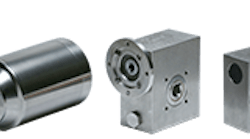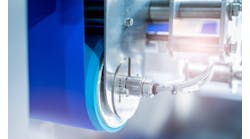Motors are getting more efficient, durable and versatile. And that’s not even the best part.
Electric motors of all kinds, and the drives that operate them, have made considerable progress over the past few decades in terms of how they use energy and how they can be used themselves. Perhaps the most intriguing is how they can be made to yield information, about themselves and the equipment they power, through the Internet of Things (IoT).
The improvements in electric motors in general mean that in some cases purchasers have to decide among options. Here is a look at several areas where motors have improved their performance:
Energy efficiency. Efficiency standards for electric motors have been established and revised during the past several decades. For the small (below 100 HP) motors that are mostly used in food and beverage plants, efficiency standards, based on the motor’s size, configuration and other factors, mostly are in the low to mid-90s. (A motor’s efficiency is, roughly speaking, its output power divided by its input current, both of which can be measured in kilowatts.) This has helped motivate motor manufacturers to keep increasing efficiency.
Motors of all sizes are being designed to resist washdowns, with stainless-steel construction and smooth surfaces. Photo: Bison Gear & Engineering
“One of the most significant developments in motors is the technology behind increasing efficiency,” says Bunnyray Larmond, general manager for food and beverage at Bison Gear & Engineering Corp. “It is being driven by the constant push for energy savings, along with the benefit of reducing size, weight and footprint of machines.”
Energy efficiency can be helped by the next factor:
Sophisticated drives. For a long time, the alternating current (AC) motors that predominate in the food industry could run at only one speed. They were fed by relatively simple drives that allowed for little or no variation in current.
But soft-start and variable-frequency drives have the potential to both save energy and increase the utility of the motors they run.
Soft-start drives allow the motor to ramp up to speed gradually, saving both energy and wear on the motor. “Soft starters help reduce the inrush current generated when starting a motor compared to an across-the-line starter,” says Rafael Contreras, food and beverage segment expert on VFD drives for ABB.
“A typical ATL starter draws six to 12 times full load amps at startup and induces a lot of stress to the system's mechanical components," he continues. "By being able to ‘soft start’ and ‘soft stop’ a motor, you can reduce both the inrush current and the system's mechanical stresses. This reduces peak demand from the utility (energy consumption), increases the life of mechanical components, reduces waste and gives the customer better control of the process.”
Variable frequency drives (VFDs) go that concept one better. They enable AC motors to speed up or slow down by changing the nature of the current that feeds them. By altering the current’s frequency – the number of times it cycles per second – it can produce the same effect as speeding up or slowing down a direct current (DC) motor by changing the voltage.
The significance of VFDs is that they allow AC motors, which are sturdier and more efficient than DCs, to adopt the flexibility of DCs. When motors can change speeds, it improves energy efficiency and versatility because the motors now are better suited to applications where varying force is needed, such as pumping a changing amount of liquid.
“Basically, a VFD allows the user to optimize the motor performance by fine-tuning it to the application,” says Rick Zander, business development manager of Van der Graaf (VDG), a supplier of drum motors.
VFDs can be used in a variety of locations in a food plant, Contreras says.
“Applications where VFDs are suitable in food and beverage plants are medium- to large-sized motors. This dramatically reduces energy consumption and eliminates the need for dampers, valves and mechanical components, thus reducing maintenance. Other applications where the need for precise speed and torque control are required are also ideal for VFDs: conveyors, mixers, grinders, centrifuges, cutters, pumps, fans, etc.” he says.
The biggest disadvantage of VFDs is cost. They’re expensive enough that they can only be used in applications where being able to vary motor speeds carries a significant ROI. In addition, they tend to be larger and more fragile than ordinary start-stop drives.
But VFDs, like drives of all kinds, are becoming smaller and more durable as technology progresses, which leads to the next factor:
Locating drives near motors. For decades, the norm was to cluster drives together and enclose them, as well as other electronic controls, in secure cabinets on the plant floor – or even in a separate room. They would be connected to motors by cabling, which could extend for dozens of yards or more.
This keeps the drives secure but leads to other problems. Long cables are hard to install and maintain. Operationally, they present problems with electric current becoming distorted as it travels the cable, causing problems with the motor.
Many end users still prefer the remote arrangement, but as drives get tougher, the option exists to mount them closer to the motors they operate. This eliminates cabling and voltage spikes, but can present other issues. One of the biggest is whether the drive, even a newer and more durable one, will be able to survive the plant-floor environment.
“In many food processing applications, many systems need to have washdown features for the cleaning process,” says Mark Nehls, a product marketing manager with Regal Beloit. “With the drive located within close proximity, the drive encloser may require a higher IP rating, which adds cost to the drive compared to a drive that is remotely mounted in a motor control room.”
Washdown resistance. Being able to withstand washdowns may be optional for drives; it isn’t for motors. Improved resistance to hot, high-pressure water and cleaning chemicals is one of the most significant developments for motors in years.
“The need for washdown-resistant motors continues to grow within food plants as cleanliness requirements become more and more strict,” Larmond says. “The motors are required to survive high-pressure and high-temperature wash downs frequently with caustic chemicals.”
Washdown resistance entails both materials and design. All-stainless-steel construction is a good first step, but other factors to take into consideration include: the integrity of the shaft seals; complete enclosure of the motor’s winding (the wire coils in the stator that induce the magnetism that makes the shaft turn); lubrication with water-resistant lubricant, often synthetic; and an overall design with sanitation in mind.
“The addition and availability of full stainless steel designs, and with mechanical enhancements such as smooth corners and reduced gaps for bacterial contamination, have grown through various manufacturers’ offerings,” says Jack Korzyp, business development manager for Motion Industries.
Certain kinds of specialty motors can be almost completely enclosed, boosting their washdown resistance. For example, drum motors pull conveyors without the belt-and-sprocket arrangement used with standalone motors. With the drive, lubrication and power transmission all enclosed, washdown resistance increases.
“Being enclosed and away from the operating environment allows for a longer lifespan or mean time between failures, due to the design,” VDG’s Zander says. “An enclosed drive like a drum motor can operate in wet, dusty, and dirty processing applications. This means zero to no maintenance is required.” VDG offers an all-stainless drum motor, the SSV series, specifically for food and beverage applications.
Other kinds of specialty motors, like servos, are also becoming available in washdown versions, says Chris Teague, food and beverage segment expert in motors for ABB Motors & Mechanical.
“Use of stainless steel construction and improved sealing is also increasing in servomotors as well,” Teague says. “The importance of food safety has placed a greater importance on equipment cleaning. As equipment endures more frequent and harsher washdown, servomotor applications would require better wash down features like induction motors.”
Improved maintenance through the IIoT. Motors and their accessories, with frequent or even constant periods of service, are especially liable to breakdowns. By monitoring them continuously with equipment that transmits data wirelessly through the Industrial Internet of Things, they can be serviced when needed and only when needed, increasing the efficiency of maintenance operations.
One choice some end users face is whether to mount drives remotely or closer to the motor. Photo: Nord Drivesystems
All inverter motors from Nord Drivesystems are IIoT-capable, says James Chandler, key markets manager. He lists the advantages as: Detection of potential equipment failure at an early stage; status-based maintenance vs. time-based maintenance; avoidance of unplanned downtimes; reduction in equipment failure, and longer service life of components and machinery.
Even without being connected to the internet, “smart” motors have the capacity to self-monitor and notify end users of conditions that need attention, Zander says.
“We can and have integrated condition monitoring into the drum motor,” he says. “The output of the monitoring device can be tailored to report/feedback on customized fields, i.e., send a signal to activate an alarm, a light, etc.”
Electric motors may be the workhorses of food plants, but there’s a lot of variation in terms of their construction and capability. Choosing the right options will keep things running and make maintenance as efficient as possible.


